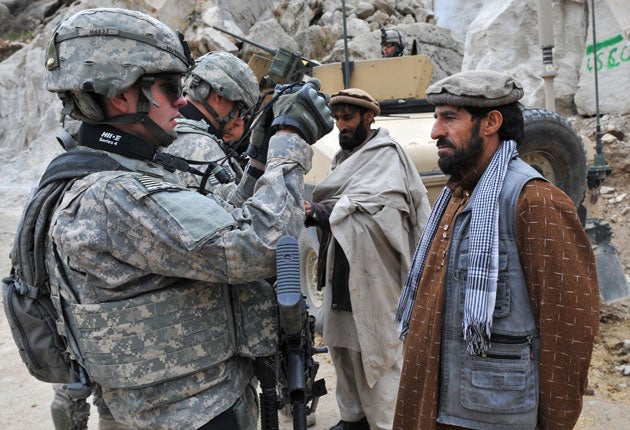Return of the Taliban: rebel-held district is sign of things to come
The white flag of the 'Islamic Emirate' of Afghanistan flies again in Nuristan province. Julius Cavendish on the insurgents' march

Set apart from the rest of Afghanistan by its soaring peaks, cedar forests and high-altitude pastures, Nuristan province is the stuff of traveller's tales. It is also the setting for some of the Taliban's most significant gains this year – for the first time in almost a decade the insurgents are administering a district unmolested by the government or Nato, which has withdrawn all but a handful of troops.
For the past two months, a relative unknown called Maulawi Zahir has held court in Waygal district after police there fled amid fears they were about to be overrun. Most government officials were long gone, and after raising the white flag of the Islamic Emirate – the name the Taliban regime went by – the insurgents looted the place, according to one local source.
"The next day they ordered people to stop going to government schools but told them they could attend madrassas," said the source, who asked not to be identified for fear of Taliban reprisals.
Zahir, the new Taliban governor, spends two hours every morning hearing local disputes. It has hardly sent his popularity soaring among Nuristan's population tucked in Afghanistan's rugged north-east, where people want little more than to be left alone by Nato, the government and the Taliban. "People aren't happy, but they pretend to be," says one local trader. "They dislike the Taliban as much as they dislike the government."
But it is the fact that no one has yet challenged Zahir's rule – despite promises by Afghanistan's interior ministry – that is worrying many as the July draw-down date nears for Nato troops to begin leaving other provinces in Afghanistan.
Nato has gradually withdrawn all but a handful of troops from Nuristan in the last few years, saying that it was more productive to concentrate forces in urban centres. Now the militants are pushing into other areas of Nuristan. At the start of May, they massed in sufficient numbers in Barg-i-Metal district, provoking an air assault by Afghan forces and their US mentors. Fighting close to the provincial capital, Parun, is said to be ongoing. And last Wednesday an Afghan and Nato force again scrambled after militants attacked Du Ab district centre in western Nuristan.
The Taliban's goals appear to be threefold. First, seizing as much of Nuristan itself as possible would grant them a safe haven. Although many fighters are local and seem to have no greater aspiration than to be left alone, commanders and foreign groups have grander strategic aims. Waygal district backs on to the Pech valley in neighbouring Kunar province, and from there it is a straight run down to its provincial capital, Asadabad. Nuristan and Kunar also border Pakistan, and the porous frontier is a key transit route for militants and supplies.
On 1 May, when the Taliban announced their spring campaign, Asadabad bore the brunt of attacks: three mortar attacks on a US provincial reconstruction team in 36 hours and assaults on the prison and police headquarters. "It was the attacks on Asadabad that stood out," says a Western security analyst, "as something very much connected to a demonstration of intent".
And the Taliban have an ear for history, remembering that the 1978 uprising against the Communist government began in Nuristan and quickly spread to Kunar. Qari Ziaur Rahman, a regional commander for the Taliban, said in a 2008 interview: "Trouble here can break the central government. Whoever has been defeated in Afghanistan, his defeat began from Kunar." Nuristan also threatens Laghman province to its south, where Nato will hand over responsibility for security to the Afghan government this summer.
Foreign groups have also been expanding their presence in Nuristan. This month a 12-year-old trainee suicide bomber accidentally killed himself, two Arab fighters, two Pakistanis said to be retired soldiers and three local insurgents.
Western diplomats say that links between the Taliban and al-Qa'ida are stronger in Nuristan and Kunar than anywhere else, and that Lashkar-e-Taiba, a Kashmir Islamist militant group, is a growing presence in the region. The group is thought to have been behind the massacre of aid workers including the British doctor Karen Woo in a mountain valley close to Nuristan last year.
Nato had hoped that local resentment of outsiders, which had fuelled the fighting against its own troops in Nuristan, would help to keep the lid on the insurgency after its departure. To an extent this appears to be happening. Residents of one district, Wama, "strongly supported the Taliban" at first, says an Afghan official. "Now they're fed up and they've withdrawn their support. They're against the Taliban and they've warned them: 'If you return we'll fight you.'"
In one illustration of this, the Taliban's shadow governor for Nuristan, Jamil Rahman, came to blows with a Lashkar-e-Taiba rival over whether or not to attack people building roads, which benefit local communities, but whom particularly diehard jihadists see as legitimate targets. This winter, the Lashkar-e-Taiba commander and his men ambushed Rahman as he went to mosque, beating him with sticks until they broke his arm.
Whether or not local antipathy to foreign jihadists is strong enough to constrain them remains to be seen. But what's happening in Nuristan now is the first snapshot of what might happen in Afghanistan once Nato leaves.
Join our commenting forum
Join thought-provoking conversations, follow other Independent readers and see their replies
Comments